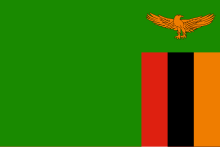This article needs to be updated. (August 2023) |
 | |
| Data | |
|---|---|
| Water coverage (broad definition) | (basic water service) 61% (2015)[1][2] |
| Sanitation coverage (broad definition) | (basic sanitation) 31% (2015)[1][3] |
| Continuity of supply | Average of 16 hours per day in 2010[4] |
| Average urban water use (L/person/day) | 77 (2010), ranging from 26 to 121 between utilities[4] |
| Average urban water and sanitation tariff (US$/m3) | US$5.80/month for metered users |
| Share of household metering | 58% (2010),[4] up from 39% (2006)[5] |
| Annual investment in WSS | US$33.5 million (2002) or US$3/capita/year |
| Share of external financing | 2% government, 98% external donors (2002) |
| Institutions | |
| Decentralization to municipalities | Yes (11 municipality-owned regional commercial utilities) |
| National water and sanitation company | None |
| Water and sanitation regulator | Yes (NWASCO) |
| Responsibility for policy setting | Minister for Local Government and Housing |
| Sector law | Yes |
| No. of urban service providers | 11 Commercial Utilities |
Water supply and sanitation in Zambia is characterized by achievements and challenges. Among the achievements are the creation of regional commercial utilities for urban areas to replace fragmented service provision by local governments; the establishment of a regulatory agency that has substantially improved the availability of information on service provision in urban areas; the establishment of a devolution trust fund to focus donor support on poor peri-urban areas; and an increase in the access to water supply in rural areas.
Among the challenges are a low rate of cost recovery despite tariff increases in urban areas; limited capacity in the sector; insufficient progress in increasing access to sanitation; a high level of non-revenue water (44% as of 2010[4]) in urban areas; a high rate of non-functioning rural water systems; and insufficient investment levels despite substantial foreign aid.
- ^ a b WHO and UNICEF (2017) Progress on Drinking Water, Sanitation and Hygiene: 2017 Update and SDG Baselines. Geneva: World Health Organization (WHO) and the United Nations Children’s Fund (UNICEF), 2017
- ^ WASHwatch Country Statistics and Country profiles for the WASH sector, 2017
- ^ WASHwatch
- ^ a b c d NWASCO. "Urban and Peri-Urban Water Supply and Sanitation Sector Report 2010/11" (PDF). Archived from the original (PDF) on 5 October 2011. Retrieved 27 August 2011.
- ^ "NWASCO Report 2007" (PDF). Archived from the original (PDF) on 2012-02-16. Retrieved 2008-09-14.